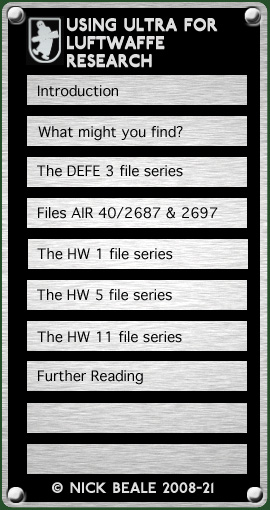The format of the messages Reports are in black ink, use both upper and lower case letters and are printed single-sided; teleprints use the characteristic blue-lilac ink of stencil duplicators (a vintage office technology) and are in upper case throughout. They are printed double-sided and occasionally the second side is upside-down. Teleprints have a heading saying which theatre of war they refer to — a great help if you’re in a hurry. By the time of the Battle of Britain, it had been decided to disguise the origin of the material by making it look as if there was a spy lurking behind every filling cabinet and under every desk in occupied Europe. You will soon get used to items beginning “Source saw a routine return from …” while breaks in intercepted transmissions are disguised by comments like “(smudge)” or “(last page missing).” Sometimes you’ll encounter “Source saw badly torn copy of …” They didn’t seem to have a typewriter with an asterisk key, so the files use “(+)” instead, usually linked to notes following the deciphered text. They have “notes” rather than the “comments” seen in DEFE 3. If you see a word or words in double brackets ((such as these)) that’s what they call an “interpolation”, something that Bletchley put in, based on background knowledge, to fill a gap in the intercepted material. Also they will sometimes uses it to number sections of a message, to simplify cross-referencing. When you see B%, C% or D%, they are the direct equivalents of DEFE 3’s strong, fair and weak indications. Times and dates of teleprints are expressed in the format 1916/21/5/44Z = 19.16 hours, 21 May 1944, Greenwich Mean Time. Teleprints can be very faint and hard to read in places. Often the text will be followed by the corresponding (and usually much briefer) DEFE 3 item. This offers a useful means of comparing the two and can help you interpret bits that are hard to read in the main text. Sometimes you may see a note “(Report for commands follows)” because the DEFE 3 version had not yet been drafted. A day’s teleprints are divided into three batches by handwritten cover sheets which will say something like “Part Three, nos. 66 – 100" followed by a start and finish time, possibly reflecting the day's three shifts. Most teleprints I’ve looked at so far have “42” written at the top right hand corner and so I infer that there were at least 41 other copies produced apart from the one that went on file. Those from the first half of 1944 have "10" in the corner however and I've not yet fixed when the change took place. continued on next page …
|
|||

